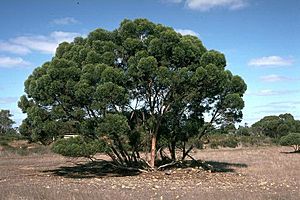Stirling Range yate facts for kids
Quick facts for kids Stirling Range yate |
|
|---|---|
 |
|
| Eucalyptus talyuberlup | |
| Scientific classification | |
| Genus: |
Eucalyptus
|
| Species: |
talyuberlup
|
The Stirling Range yate, also known as Eucalyptus talyuberlup, is a special kind of small tree or a mallee. A mallee is a type of eucalyptus that has many stems growing from a woody base. This plant is found only in a small part of the Great Southern region of Western Australia. It has smooth bark, shiny green leaves, and its flowers are yellowish-green. After flowering, it grows bell-shaped or cup-shaped fruits.
Contents
About the Stirling Range Yate
The Stirling Range yate is usually a mallee, growing up to 5 meters (about 16 feet) tall. Sometimes, it can grow into a tree reaching 10 meters (about 33 feet) high. This plant has a special woody swelling at its base called a lignotuber. This helps it regrow after fires.
Bark and Leaves
The bark of this eucalyptus is smooth and can be pale grey or pinkish. It peels off in long strips. Young plants and new shoots have egg-shaped leaves that are about 5 to 8 centimeters (2 to 3 inches) long and 3.5 to 6 centimeters (1.4 to 2.4 inches) wide.
The adult leaves are arranged alternately along the stems. They are shiny green on both sides and shaped like a narrow spear. These leaves are usually 4.5 to 10.5 centimeters (1.8 to 4.1 inches) long and 0.6 to 2 centimeters (0.2 to 0.8 inches) wide. They narrow down to a stalk, called a petiole, which is about 0.5 to 1.5 centimeters (0.2 to 0.6 inches) long.
Flowers and Fruit
The flower buds grow in groups of seven to thirteen in the axils of the leaves. An axil is the angle between a leaf and the stem. These buds are on a stalk called a peduncle, which is 1.7 to 3.2 centimeters (0.7 to 1.3 inches) long. The individual buds do not have their own stalks; they are directly attached.
When the buds are ready, they are quite long, from 1.9 to 6.3 centimeters (0.7 to 2.5 inches) long and 0.3 to 1.3 centimeters (0.1 to 0.5 inches) wide. They have a horn-shaped cap, called an operculum, which is much longer than the base of the flower.
The Stirling Range yate flowers between March and August. Its flowers are a greenish-yellow color. After the flowers, the plant produces woody fruits. These fruits are bell-shaped or cup-shaped capsules, about 1.1 to 2.2 centimeters (0.4 to 0.9 inches) long and 1.3 to 1.8 centimeters (0.5 to 0.7 inches) wide. The valves, which are parts of the fruit that open to release seeds, are fused at their tips.
Where It Lives
The Stirling Range yate grows in dense shrubland. You can find it from the base of the Stirling Range mountains all the way to the Kalgan River.
Discovery and Name
Eucalyptus talyuberlup was first officially described in 1980. Two scientists, Denis John Carr and Stella Grace Maisie Carr, wrote about it in a science journal called the Australian Journal of Botany. They had collected samples of the plant in 1974.
Conservation Status
The Western Australian Government's Department of Parks and Wildlife has looked at the Stirling Range yate. They have classified it as "not threatened," which means it is not currently in danger of disappearing.
Images for kids


